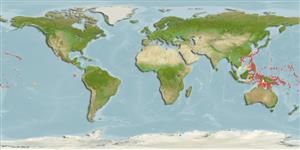Classification / Names
Common names from other countries
Main reference
Size / Weight / Age
Max length : 6.0 cm TL male/unsexed; (Ref. 9710)
Environment
Marine; reef-associated; depth range 4 - 40 m (Ref. 1602), usually 4 - 40 m (Ref. 27115)
Climate / Range
Tropical; 22°C - 25°C (Ref. 27115), preferred ?; 30°N - 15°S
Distribution
Short description
Dorsal
spines
(total): 7;
Dorsal
soft rays
(total): 10-11;
Anal
spines: 1;
Anal
soft rays: 10 - 11. Characterized by having semi-translucent whitish body; orange spots interspersed with small white or bluish spots on body; dorsal fin brownish "pennant"; basal part of pectoral fin with white marking forming long, diffuse narrow white streak; greatly prolonged first and second dorsal spines; longitudinal scale series 47-51; opening of gill extending forward to vertical at posterior edge of eye; greatest depth of body 4.3-5.2 in SL; rounded caudal fin, except straight in central part, about equal to head length (Ref. 90102).
IUCN Red List Status (Ref. 115185)
Threat to humans
Harmless
Human uses
Aquarium: commercial
More information
Common namesSynonymsMetabolismPredatorsEcotoxicologyReproductionMaturitySpawningFecundityEggsEgg development
ReferencesAquacultureAquaculture profileStrainsGeneticsAllele frequenciesHeritabilityDiseasesProcessingMass conversion
Tools
Special reports
Download XML
Internet sources
Estimates of some properties based on models
Phylogenetic diversity index
PD50 = 0.5020 many relatives (e.g. carps) 0.5 - 2.0 few relatives (e.g. lungfishes)
Trophic Level
3.3 ±0.4 se; Based on size and trophs of closest relatives
Resilience
High, minimum population doubling time less than 15 months (Preliminary K or Fecundity.)
Vulnerability
Low vulnerability (13 of 100)
Price category
